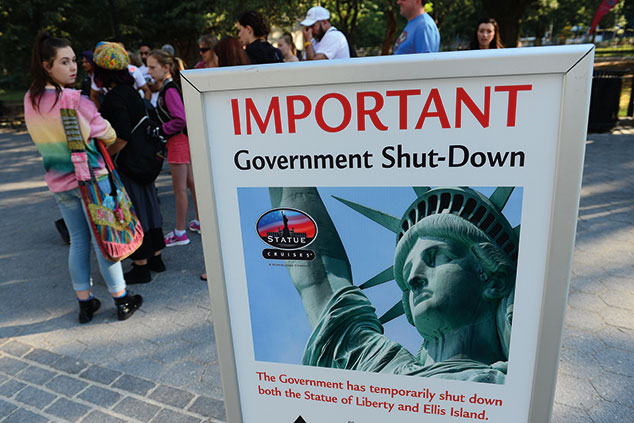
What has happened?
Since 22 December, the US federal government has been in partial shutdown after Congress refused to agree to $5.6bn in funding for President Trump’s long-promised wall along the Mexican border – a barrier regarded by Democrats as not merely a crazy waste of money, but also immoral. As MoneyWeek went to press, the Trump-imposed shutdown had lasted 19 days – the second-longest in US history. And if it continues until this weekend (and there’s every sign that it will), it will be the longest shutdown ever, surpassing the 21-day shutdown under Bill Clinton in December 1995 and January 1996.
What’s a “partial” shutdown?
In this case, only around a quarter of federal agencies are affected, and must freeze all non-essential, discretionary activity. Since the US government’s fiscal year began on 1 October, Congress had already passed five of the 12 necessary “appropriation bills” that settle funding for the various federal departments and agencies before the current stand-off began. Thus key aspects of government (defence, energy and water, the legislative branch, the departments of labour, education, health and human services) are unaffected by the funding gap and shutdown. The departments worst affected are homeland security, justice and agriculture (which together account for about half the 800,000 workers affected). Other big departments affected are housing, commerce, interior and treasury.
Aren’t these shutdowns quite common?
They are less common than they were in the 1980s, but they last longer – and so are potentially far more destabilising. Since Congress passed the Congressional Budget and Impoundment and Control Act in 1974, which established the current regime that governs the federal budgeting process, there have been 22 occasions when funding shortfalls caused by political standoffs led to a shutdown. Only ten of these led to federal workers being “furloughed” – placed on unpaid leave – resulting in an actual shutdown of government services. In the 1980s there were shutdowns most years, but lasting just one or two days, and there was a three-day shutdown in 1990. But in the 28 years up to 2018 there were only three more: one of five days in November 1995; the 21-day shutdown that began a few weeks later and, after a gap of 18 years,
a 16-day shutdown over Obamacare in 2013.
Do they matter to the economy?
The prospect of the shutdown helped send US stocks falling in the run-up to Christmas, so it hasn’t exactly been a boon for investors. As for the real economy, there is definitely some negative impact – but most analysts expect it to be marginal rather than catastrophic (assuming the shutdown doesn’t drag on for months). Economists reckon the 2013 shutdown (16 days) cost the economy about $24bn, shaving at least 0.2% off US GDP. The negative effect comes partly from the workers (in this case 800,000) not getting paid. One study (by Scott Baker and Constantine Yannelis) found that in 2013 federal workers who were furloughed immediately cut household spending by 15%-20%.
That’s a non-negligible effect. But beyond the effect on household spending, the shutdown damages the economy in numerous small ways: from delaying business permits and visas to cutting services at innumerable agencies.
Such as?
To give a few examples, right now US brewers can’t get approval from the Bureau of Alcohol, Tobacco, Firearms and Explosives for new beer labels, holding up product launches. The commerce department has stopped processing requests from car-parts suppliers (for example) seeking an exemption from Trump’s metal tariffs, so they don’t know the price they’ll be paying for key materials. Farmers can’t get help with subsidies to counteract the effects of Trump’s trade war. Tens of thousands of federally backed mortgage applications have been delayed (according to estimates from Zillow).
The key US financial regulator, the Securities and Exchange Commission, is operating with just a few hundred staff (those tasked with “protecting life or property”) rather than its usual 4,400. That means no-one is reviewing initial public offering or mergers and acquisitions applications. And because agencies such as the Bureau of Economic Analysis have also shut, investors, businesses and policy makers are all lacking key economic data.
What’s the worst-case scenario?
What’s different about this shutdown is that analysts don’t see any obvious route to an early resolution. Trump says he’s “proud” to shut down the government, and this week commandeered the TV networks to declare he is digging in for the long term. The Democrats accused him of governing by “temper tantrum”. According to Capital Economics, the biggest risk to the economy for 2019 isn’t a worsening of the US-China trade war, but that a long shutdown could develop into another debt-ceiling crisis.
Why’s that so important?
Congress has to agree at the start of March either to raise or suspend the legally mandated debt ceiling (likely to be about $22trn), but in the current environment, such agreement could be unlikely. Trump’s own treasury department warns that such a scenario could cause the government to default on its obligations, points out Gina Chon on Breakingviews.com – an “unprecedented event that would almost certainly spark another financial crisis”. Moreover, other forthcoming political battles, such as whether Congress will approve a revamped Nafta, could be “used to hold the debt limit hostage. These would have far more scary consequences for the economy than the current shutdown”.